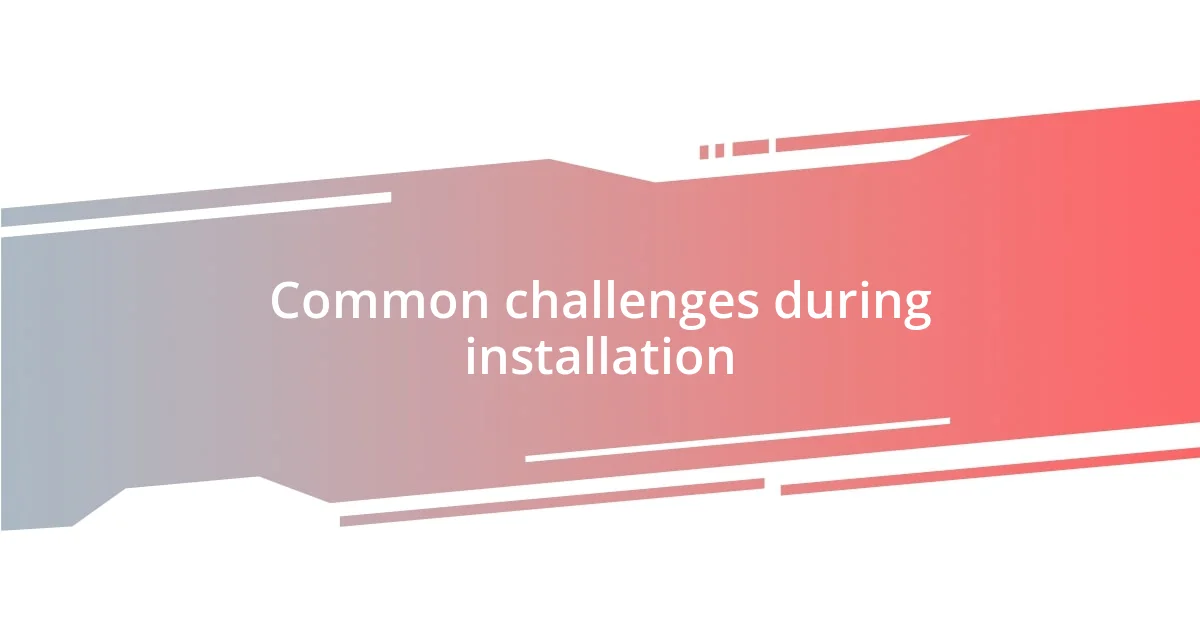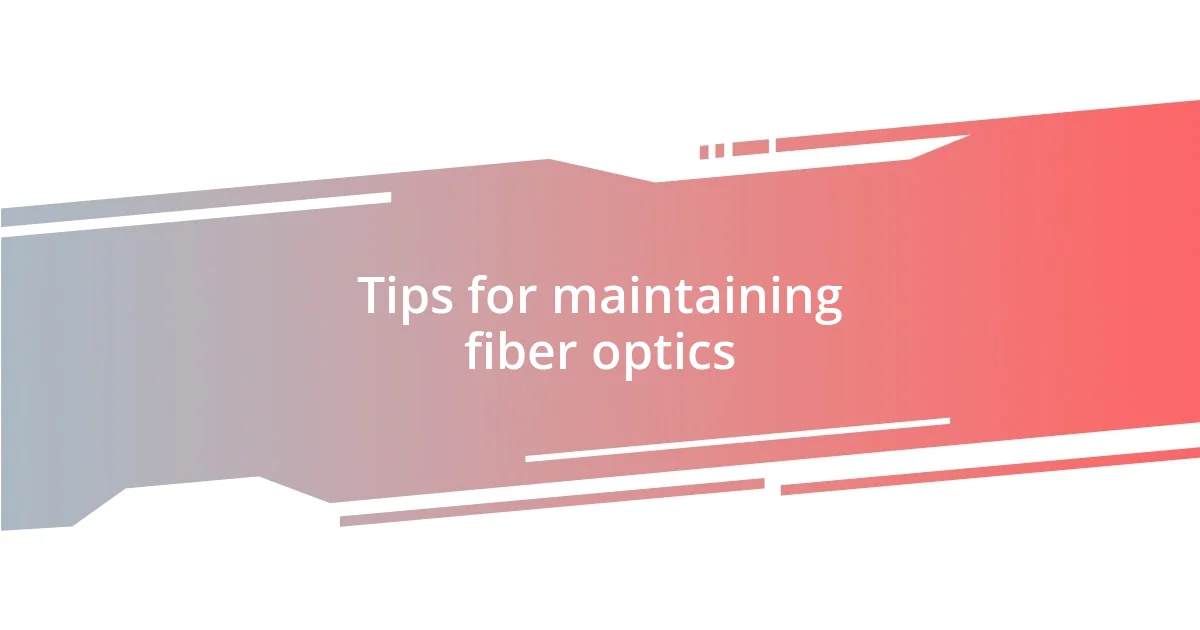Key takeaways:
- Fiber optics technology utilizes light for data transmission, significantly improving connectivity and enabling seamless communication, remote work, and education.
- Proper planning for installation includes assessing the site, choosing the right cable type, and budgeting for costs, ensuring a successful setup.
- Testing and regular maintenance are crucial, with attention to detail and documentation playing vital roles in troubleshooting and ensuring optimal performance of fiber optic systems.

Understanding fiber optics technology
Fiber optics technology is fascinating because it uses light to transmit data. Imagine tiny strands of glass or plastic, thinner than a human hair, carrying information at the speed of light—it’s mind-boggling! I remember the first time I witnessed a fiber optic cable being installed; the technician explained how the light pulses travel long distances without losing strength, and I felt a sense of wonder about how much we take our connectivity for granted.
The core principle behind fiber optics is total internal reflection, wherein light bounces within the cable without escaping. It made me think: how did we ever manage with slower technologies? As the technician manipulated those delicate strands, I realized that this wasn’t just about technology; it was about weaving a network that connects lives and civilizations, enhancing our ability to communicate almost instantaneously.
I’ve seen the transformation fiber optics bring to both homes and businesses. When my neighborhood made the switch, it felt like unlocking a new realm of possibilities. Video calls became seamless, downloads sped up dramatically, and streaming became virtually buffer-free. This shift didn’t just enhance our internet experience; it created opportunities for remote work and education, allowing us to stay connected in challenging times. Isn’t it incredible to think how this technology has changed the way we live, work, and interact?

Planning for fiber optics installation
Planning for a fiber optics installation involves several crucial steps to ensure a smooth process. I remember when I first undertook a project to install fiber optics in my home; the initial planning phase felt overwhelming yet exciting. One of the first things I did was assess the layout of my property, mapping out where the cables would run. This visualization helped me identify potential obstacles, like trees and existing structures, which could interfere with the installation.
Another important aspect is understanding the type of fiber optic cables suitable for your needs—single-mode or multi-mode. I learned that multi-mode cables are ideal for shorter distances, while single-mode is the go-to for long-distance transmission. This distinction was vital for my installation, as I wanted to ensure optimal speed and efficiency. It also meant considering how many connections or drops I would need throughout my space, which added another layer to my planning process.
Budgeting for the installation can also be tricky. Initially, I underestimated the costs, thinking it would be a straightforward expense. However, I quickly realized that factors like labor, equipment, and any necessary permits could add up. Reflecting on that experience, I found that having a detailed budget and timeline helped me to feel more secure as the project moved forward. It’s crucial to keep in mind that proper planning sets the stage for a successful installation.
| Planning Steps | Considerations |
|---|---|
| Site Assessment | Identify obstacles like trees and walls |
| Cable Type | Choose between single-mode and multi-mode |
| Budgeting | Estimate costs for labor and permits |

Tools needed for installation
When gearing up for a fiber optics installation, having the right tools is essential to ensure everything goes smoothly. I vividly remember feeling a mix of excitement and nervousness as I organized my toolkit. Each instrument had its purpose, and being prepared helped me feel a sense of confidence as I dove into the project.
Here’s a list of tools that will make your installation much easier:
- Fiber Optic Splicer: This tool is essential for joining two fiber ends together. I often found myself relying on it when ensuring a seamless connection.
- Fusion Splicer: If you’re working with splicing, this tool creates a permanent connection, resulting in minimal loss of signal. The first time I used one, I marveled at how efficient it was.
- Cable Stripper: This helps remove the protective coating from the fibers without damaging them. I learned the importance of precision: a little slip can create a significant headache later on!
- Fiber Optic Tester: This device checks if the fibers are functioning correctly. I felt a sense of reassurance after using this tool to verify that everything was operating as it should.
- Cleaver: This tool cuts the fibers cleanly, ensuring a proper splice. I remember practicing several cuts before I got it just right—it can be a bit tricky at first!
- Safety Gear: Don’t overlook protective eyewear and gloves. The first time I handled fiber optics without proper gear, I was reminded that safety should always come first.
Having these tools ready not only saves time but also adds to the overall satisfaction of the installation process. Looking back, I truly appreciate that every tool played a vital role in bringing my fiber optics project to life, transforming my home into a hub of connectivity.

Step-by-step installation process
Once I had my tools ready, I moved onto the actual installation process. I began by carefully measuring and marking the pathways where the cables would run. I vividly recall the nervous excitement as I drilled into my walls for the first time; it felt like a leap of faith. As I laid out the fiber cables along the marked paths, I made sure to keep them taut but not overly strained. Striking that balance is essential—too tight, and you risk breakage; too loose, and it can lead to performance issues later.
Next, I tackled the splicing. This part of the process can be daunting, especially for beginners. I remember holding my breath, aligning the fibers as I set them into the fusion splicer. It’s a critical moment; one misalignment could result in a poor connection. I found that staying focused and calm was key. After a few successful splices, I felt a wave of relief and accomplishment wash over me. Seeing those fibers come together seamlessly gave me a rush—I was really doing this!
Once splicing was complete, I shifted my focus to testing the connections. This is where all your hard work comes together, and I recommend not skipping this step. I used my fiber optic tester to check each connection, noting the results on a notepad. Every time I received a “pass” signal, my confidence grew. You know what’s incredible? The moment I recognized that my installation was fully operational, I felt a profound sense of achievement. It wasn’t just about the technical aspects; it was about transforming my space and making it truly functional.

Common challenges during installation
During my fiber optics installation journey, I encountered several common challenges that tested my patience and skills. One moment that stands out was when I miscalculated the length of the fiber run, causing me to scramble for extra cable. I learned firsthand how crucial careful planning is; double-checking measurements can save hours of frustration. Have you ever faced a hiccup in your project that made you rethink your approach? For me, it was a humbling reminder that a small oversight can quickly turn into a significant setback.
Another challenge was managing the delicate fibers themselves. I vividly recall the anxiety that bubbled up when I accidentally bent a fiber too sharply while routing it through tight spaces. This is a crucial lesson: fiber optics require careful handling to avoid damaging the strands, which can lead to costly repairs or replacements. Reflecting on that moment, it became clear to me how mindful we must be throughout the entire installation process. Have you ever considered how attention to detail can make or break your project?
Lastly, I found that communicating with the utility company posed its own set of challenges. There were instances where unclear instructions led to delays in gaining access for installation. It made me realize the importance of establishing solid communication before starting any project. Have you experienced unexpected roadblocks due to miscommunication? By preparing adequately and keeping lines of dialogue open, I learned to navigate these hurdles more effectively, thereby ensuring a smoother installation process moving forward.

Testing and troubleshooting techniques
Testing connections in fiber optics is not just critical; it’s an exhilarating part of the process. I vividly remember using my optical time-domain reflectometer (OTDR) for the first time. That sound of the device as it scanned through the fiber felt like a suspenseful countdown to good news. Seeing the results pop up, knowing I had successfully connected everything, was fulfilling—almost like receiving a “gold star” for your hard work. It’s a moment where all the tension dissipates, and you realize your meticulous efforts really paid off.
When troubleshooting issues, my approach was to start with the basics. I recalled a time when my signal was weak, and I felt a twinge of panic. Instead of allowing it to overwhelm me, I methodically checked the connectors and splices for signs of damage or dirt. It reminded me how essential it is to keep your workspace clean; even a small speck of dust can disrupt the signal. Have you ever overlooked something simple that turned into a much larger problem? It’s always those little details that can lead to frustrating outcomes.
Another technique that proved invaluable was using a power meter and light source for ongoing diagnostics. I distinctly remember a day spent with these tools, addressing what seemed like an intermittent fault. By carefully measuring the light loss across various sections, I pinpointed where the issue lay. The thrill of solving that puzzle felt amazing. It taught me patience and persistence. Have you ever felt this rush when overcoming a challenge? That sensation, knowing you’ve turned a potential disaster into a success, is what pushes me to embrace the complex journey of fiber optics installation wholeheartedly.

Tips for maintaining fiber optics
When it comes to maintaining fiber optics, regular inspections are essential. I remember one project where I didn’t check the connectors often enough, which later led to performance issues. It’s kind of like keeping an eye on your garden; you need to be proactive to nip potential problems in the bud before they grow out of control. Have you ever ignored a small issue that later snowballed into a bigger problem?
Handling fiber optics with care is another key point. During one installation, I unknowingly left some cables out in the open, exposed to potential damage. I was fortunate to catch it in time, but it really drove home the lesson that environmental factors—think dust, moisture, or even UV light—can significantly impact longevity. Has there ever been a time when a small change in your environment had unintended consequences? It’s a reminder that vigilance matters.
Lastly, don’t underestimate the role of documentation in fiber optics maintenance. I made it a habit to jot down every change made and each test performed. One day, I had to refer back to my notes during a troubleshooting session. I was grateful for that documentation; it saved me time and frustration. It’s like keeping a diary of your work—the more you document, the easier it is to track down any anomalies later. Do you have a system for keeping track of your projects? Sometimes, those little records can be your best allies.















